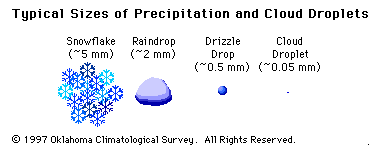|
|
||
|
|
| |
|
|
|
|
|
|
Principle |
The hydrologic cycle is a continuous process by which water is transported from the oceans to the atmosphere to the land and back to the sea. One of the most important processes in the hydrologic cycle is precipitation. |
|
|
|
|
|
|
Figure 1 - Comparison of Typical Sizes of Cloud Droplets and Precipitation | |
|
|
 | |
|
|
Overview |
|
|
|
|
|
|
|
End |
|
|
| |
|
OK-FIRST
Project, Oklahoma
Climatological Survey,
100 East Boyd Street, Suite 1210, Norman, OK
73019. |